A Fly Fishing Walk in the Catskills with Jon Scieszka
"When I come back from fishing, I can deal with anything."
“First we fish. Then we drink.”
Jon Scieszka and I are walking a waterfall-filled stream in the hills that surround West Kill, New York. The sun is high in the sky, but the forest keeps us shaded and cool. Save an abandoned sugar shack and the occasional stone wall, we won’t see any other signs of human life for our entire walk. Which is how Jon likes it. Other humans might spook the fish.
When I first moved to New York City in 2013, I had one of those very “Only in New York City” moments: I discovered that my backyard neighbor was the one and only Jon Scieszka, author of The Stinky Cheese Man and Other Fairly Stupid Tales, plus a lifetime full of other wonderful books. And when I say “backyard neighbor” I don’t mean we were in the same neighborhood or even that he lived halfway down the block. I mean that the backyard of the building I was living in and the backyard of the building he was living in were literally back to back. Over our fences we got to know each other, and eventually he invited me for a drink. A friendship began to blossom. A few years later, Jon helped me write my first children’s book, How to Be a Pirate. The book is dedicated to him.
Jon and I have kept in touch over the years—our friendship growing—and I sometimes stay with him and his family here in the Catskills, where his daughter, Casey Scieszka (who is also a writer), and her husband, Steven Weinberg (an artist with whom Jon collaborates), run a charming hotel called the Spruceton Inn along with their two daughters and dog, Waldo (more on him in a little bit). When I visit, Jon and I walk the area’s wooded streams and go fly fishing. Sometimes I catch something, sometimes I don’t (Jon always does), but that doesn’t really matter. What matters is the conversation. Not simply between Jon and I, but between us and our surroundings. When you’re out here walking, as Jon puts it, “You’re in conversation with the fish. You’re in conversation with the water.”
Isaac: What do you love about fly fishing?
Jon Scieszka: It’s always a good moment to catch a fish. Whatever size it is, wherever you are, you can’t beat that feeling. You accomplished what you set out to do. You thought like a fish. You outwitted the fish. Even though the fish has a brain the size of about half a peanut, it still feels good. You really did something.
I: You put the fish back in the water?
JS: Yes. Catch and release. It’s important to keep the wild population going. The only thing I take out of the water are brown trout, because they aren’t native to these waters. They were introduced from Germany around one hundred and fifty years ago. They’re just voracious predators. They’ll eat every other fish in here. So I take those out, to help the native fish prosper. Well, that and they’re good eating. Wild fish always tastes so good.
I: Did you fish as a kid?
JS: I grew up in Michigan, fishing lakes during the summer. A classic bobber and a worm situation. Catching sunfish and bass. That was my summer activity. And it was also a great way to get away from my five brothers, not to mention mom and dad. So yeah, I always loved it, I thought fishing was the absolute best—and it was a great excuse to get out in the wild. Walking in the woods, and it still works like that for me.
I: When did you first start fly fishing?
JS: When I first moved to New York—in 1979—I started reading about the Catskills. So then I decided to buy some fly fishing equipment, but I didn’t know what I was doing. Simply floundering around in waders. Then I read about this fly fishing school run by Joan Wulff, one of the most famous fly fishers in the world. And her school was simply spectacular. She was probably in her 70s at the time. Now she’s in her 90s, and she’s still out here fishing. Because the heart of fly fishing is right here. It’s here in the Catskills.
I: Is that what brought you to West Kill?
JS: Yes, in a way. I would come up here on fly fishing trips. Then, when my daughter opened the Spruceton Inn in 2014, I was jealous. “I want to live up here!” Because I’d been coming up here for so many years from Brooklyn. I would take these trips up to Roscoe, NY and go fishing. Standing up here in rubber pants, clearing my head.
I: You mention rubber pants, but let’s talk about that. Because right now you simply have a rod. Not a lot of gear.
JS: Over the years I’ve been stripping away the equipment. That’s the beauty of small stream fly fishing. I’ve got shoes that can get wet, and the rod, but other than that I could simply be out for a walk. And even the rod, this reel is the same type of reel as the guys used fishing Isaac-Walton-style in England four hundred years ago. A rod, some line, and a reel. Just the most elemental. There's one other step of fly fishing called, “Tenkara.” That’s just a rod with a piece of line on it. No reel. It’s an even more simplified style of fly fishing from Japan. I have a Tenkara rod and I really enjoy that too. It’s so peaceful.
But let’s keep walking the stream. I want to take you to the next waterfall.
Did you know Scieszka means “path, or path through the woods”? It's a close cognate to a Polish word. You drop the second S and you get the word that means “path.” My grandfather's family came out of Southern Poland, and I think they were guides in the Tatra Mountains. Similar to the way you would call the guy who works building barrels Cooper? Or Smith was the blacksmith. So Sciezka was the guy who would guide you through the mountain paths.
I: So in a way, this is in your blood.
JS: Even as a kid I would be out in the woods, always wandering around. Looking for a path.
I: Have you ever written a children’s book about hiking or fishing or anything like that?
JS: Only incidentally, but not really. Though I’ve always loved to read stuff like that. My Side of the Mountain, by Jean Craighead George, which is set right here in the Catskills. Gary Paulsen’s Hatchet. Swiss Family Robinson. Post-apocalypse fiction like Russell Hoban’s Riddley Walker, Walter Miller’s Canticle for Leibowitz. I think it’s the fight for survival I like.
I: So is walking a part of what you love about this type of fishing? Walking the stream?
JS: Oh, that’s a huge part of it. Because it’s this beautiful brain reset. When you’re out here, you’re not thinking about anything else. I’m not thinking about ideas for the next book, or what the most recent publishing news is. I’m simply thinking, “Where’s the next fish? Am I thinking like a fish? Is this the right fly? Is there a fish under that rock?” And I’m simply walking.
I: Do you find that peacefulness to be part of the joy in fly fishing?
JS: Absolutely. And when I come back from fishing, I can deal with anything. That’s the time to ask me for anything, really. That’s when I’m Mr. Mellow. It’s top secret, so don’t spread it around, but if you’re looking for a favor from me ask me when I get back from fishing. I’ll say yes to anything.
Oh hang on. I think we’ve got a friend under that rock.
I: What sort of wildlife do you see out here? You know, other than fish?
JS: Oh, a bit of everything. Deer. Turkeys. Raccoons. Mink. Beavers. Eagles. Hawks. We hear a bunch of coyotes, too. In the spring, after the coyotes birth their pups, they kick them out of the nest—out of their little den, so the young coyotes have to go find their own turf. Around that time they're all howling like maniacs. The parents are howling, saying “Get the hell out of here!” And the teenagers are yelling back, from the other side of the valley, “Screw you, mom and dad!” And those howls surround us. So the granddaughters do an amazing imitation of coyotes.
And I think Steven and Casey’s dog, Waldo, is a mutt version of a Plott hound. It’s a hunting dog bred to chase bears and tree them—which is chasing a bear until it crawls up a tree. So it’s probably in Waldo’s blood to chase bears. So he disappeared for a while and then came back a little kind of out of sorts. And when Steven was brushing the burrs and ticks off of Waldo, he noticed he had a hole in his back and some scratches. So Steven took him to the vet and the vet said, “Oh, yeah, he got bit by a bear. Mauled a little bit.” Which I thought was a funny phrase. “Mauled a little bit.” But it definitely sounded like Waldo was in The Revenant. He was not in good shape. But he’s better now. An old dog with bear scars. So we have bears around here too.
I: What do you enjoy about writing for children?
JS: I started teaching first grade and second grade because, well, I was writing fiction but nobody was buying it, or reading it. So I started teaching. And these kids? These kids believed all of it. Every story I told them. They were the best audience for suspending disbelief ever. So I would tell them all of my favorite stories. I would tell them Borges stories, Calvino stories, Kafka stories. “There was this guy who woke up and he was a bug.” And they would all go, “Yes, that could absolutely happen.” And I was like, “Yep. That can totally happen.”
So I was teaching, making $8,000 a year. Luckily Jeri, my wife, was working as an art director and making more. So I was sending out stories to The New Yorker, Esquire, and Playboy, hoping they would simply love weird meta fiction. They did not. And that’s when I had one of those lightbulb moments, “Why am I writing for adults?” Look at these kids. They love these stories. And at the same time I was getting an education too. Because I was reading all the Frog and Toad books, and Roald Dahl and George and Martha—and I would read them twenty times a day with struggling beginning readers, and these perfectly crafted tales would still be entertaining every single time. And then at home I was reading John Barth and Thomas Pynchon. And I still do, those are my favorite writers—the ones who dick around with forms of storytelling and deconstruct it. Don Quixote. Borges. So I would figure out how to tell those stories to kids.
So that was the shift. I was sitting in a room, writing for myself. Or worse, writing for an imagined audience. But this audience—the kids—they’re right in front of you. And if you don't capture them, you're screwed. You start with one sentence, and every sentence after that better mean something. Better be better and more entertaining than the one before it. Otherwise, someone's rolling around picking their nose. Somebody's taking a nap. And that was the drive behind the Stinky Cheese Man fairy tale variations. To reach that person in the back of the room. The kid who was zoning out.
I: So is that when you decided to pursue writing for kids?
JS: I took a year off from teaching to write, with Jeri’s encouragement. I said, “We have kids. There’s no money in this. It’s not the right time.” And she said, “Well, there’s never going to be a right time.” I had been painting houses and offices in the summers, to make a little extra money. I knew a guy whose apartment I had painted on the Upper East Side. He was a lawyer down on Wall Street. He asked me to paint some of his offices down there, on Exchange Place—it’s a really cool looking building. So I asked him, “Any chance I could use one of your empty office rooms? For writing? I need some place to go.” And he said yes.
I: Can I ask how old you were when this happened?
JS: Mid thirties, maybe? 34?
I would go there every day and commute with the lawyers and the bankers and the suits and sit down in that office and write. I remember writing in that room by hand, mostly, although I definitely had manuscripts printed out too. I had a few of those big, black, floppy disks that were cutting edge technology. Remember those? The office had some kind of monster word processor that they let me use for typing. But I love to write by hand. Still do.
So I used that office for at least six months, and that’s where I wrote The True Story of the 3 Little Pigs!, as well as a whole bunch of other things that got rejected. Because that’s what I was getting those days. A whole pile of rejection letters. Pure form letters too. Nothing nice, nothing personal. Just form letter rejections with my name misspelled at the top. But the second I had the thought, “What about a weird fairy tale?” Then all my formal training locked in. I realized I could tell the story from a different point of view. Use an unreliable narrator. I love an unreliable narrator. Who doesn’t?
Of course, even Pigs got a bunch of rejections. At that time the beginning of Stinky was starting to come together too, in a few of those fairytales I was sending out. But publishing people were all saying, “These are too weird. Plus they’re kind of mean. Kids won’t understand them.” And that’s when I was like, “Well, now I know you’re fucking wrong. Because the kids I read these stories to love them.” And that’s when I started realizing how disconnected publishing often is from kids and what kids are capable of understanding.
I: So Pigs is published before Stinky, right? It’s your first book. How does it end up getting published?
JS: Well, that’s when I meet Lane Smith. Jeri was an art director at a magazine and Lane had done some work for her, so Jeri introduced us. And Lane is absolutely brilliant. One of the first times we hung out, I think we went to the zoo together. Simply walking around. And it quickly became clear that he loved all the things that I love, but with an art bent. He loved that same kind of deconstructed, modern art. And we liked the same kind of cartoons, and different types of storytelling. And he has this incredible, dry sense of humor.
So he said, “I hear you’re writing stories. Let’s work on something together.” So I sent him a bunch of my writing. Which is when he started taking things around, because I had sent the manuscript out and it had been getting rejected for another good six months. I was still painting apartments. Then Lane started getting the same types of reactions. “Kids won’t get this. It’s too dark. Your artwork is too sophisticated.”
But then Lane goes to Penguin, and they love his artwork. An editor there—Regina Hayes—says, “Wow, this art looks great. But I don't have anything for you to do right now. No projects that are a good match.” And Lane goes, “Well, there’s this thing my friend Jon wrote...”
So Lane pulled Pigs out of his portfolio and she read it right there while he's sitting across from him behind her desk. And she likes it! Lane had a couple of sketches and drawings he had done of the wolf with some bloody pig paws. Really dark stuff. But she liked it. She thought it was funny, so she told him right there while he was in her office, “Ok. Let’s try this.” And Lane goes, “Really?!” It was something out of a movie. To have a book deal happen like that. Because Lane had been getting rejected everywhere, too. And it still took some time, because publishing always takes time. But a few months later I got the call—probably from Regina herself—saying she liked the manuscript, and wanted to buy it. And I was like, “Oh, my God.” It had finally happened. I didn't even ask about the money. I just said yes.
And I remember—of course this is later—but I remember Lane and I walking over to the Barnes and Noble on 14th Street in Manhattan and seeing Pigs in the window for the first time. And we both cheered. We were so excited. Thrilled to see our own book, out there in the wild. Turning to people passing by, “That’s our book!” And nobody caring because it’s New York City. Saying to dogs walking by, “That’s our books!” And the dogs didn’t care either. But I distinctly remember standing there for a long time, outside of the bookstore. Taking it in.
I: Have you missed reading to kids in person this past year?
JS: I have missed kids hugely. The energy you get from them—that’s what makes the writing. That’s what makes the story. The way kids react to it, and interact with it. That’s why you need to know your audience. You need to know kids. Whenever someone comes to me with a manuscript, asking me what I think of it. The first thing I say is, “Go read it to a group of kids you don’t know. Not your niece. Not your nephew. A bunch of kids you don’t know. And if they don’t eat you alive? Maybe your manuscript has got a chance. Maybe there’s something there.”
I did that with Stinky. Because Pigs was a hit, so Lane and I started touring like mad, but that’s the only book we had. So we read it like 500 times, until I got so sick of it. I would just pull out anything I had in my folders. And I distinctly remember reading a rough draft of Stinky to a group of 8th graders at the end of the day. The biggest bunch of smartasses you’d ever want to meet. Of course! Because they’re 8th graders and it’s the end of the day. I said, “Man, I’ve got to give them something new,” so I pulled out these messed up stories that I figured wouldn’t work. But what did I have to lose? It was 8th graders. At the end of the day! Did I mention that? So I read them some early pages from Stinky and they started cracking up. And all of a sudden the vibe in the room changed. And we were all laughing and I thought to myself, “There might really be something here.”
I: So you’re really missing live events?
JS: I really am. I mean, obviously so much of the past year and a half has been crushing. So really it’s a small thing. But doing events on Zoom with kids is just sad. And the teachers are so worried about the kids misbehaving. They have the kids mute themselves and turn off their chats, so you’re getting no feedback. And I’m saying, “No, no, no. Turn it on! I don’t care. I want the kids to make noise.” Because that’s who I want to hear from. The kids. Even after thirty years of doing this, I always get a question I've never heard before. When you’re talking to a bunch of kids you’re going to get that fresh take every time.
I: What do you think it is about kids that make them so open to new ways of thinking?
JS: They haven’t internalized the rules, yet. That’s what I learned teaching kids for ten years. First and second graders, that’s my crew.
I: When do kids lose that openness?
JS: It’s a gradual thing, and it comes from comparison. You lose a little in first grade. “Jack’s a better drawer than me.” And then in second grade you go, “I can’t dance. Claudia’s the best dancer.” So slowly, over time, all the possibilities start falling away. And they begin to internalize all those adult rules, and limit themselves. So I don’t mind when kids are acting up when I’m doing a school visit, even over Zoom. I’m encouraging it. Once this past year the kids were going nuts in the chat section, just writing “poop” over and over again. “Poop. Poop! Poop!!” But that’s the anarchy I love. Because a school visit, you know, it’s a break in the day for these kids. They deserve a distraction from math class, and they definitely deserve a distraction from what we’re going through now. So if they want to write “poop” while I’m reading them a story? I’m going to encourage it. Because I’m always going to be in favor of breaking the rules.
By now Jon and I have walked back down the stream and into the valley. We head over to West Kill Brewing, where we have tacos and beer. The fishing is over, so now we can drink. Jon tells me about Art Flick, a famous local fly fisher who, at one point, studied bugs for two or three years. “Didn’t fish at all, just looked at every bug that would hatch on the water. And then he started making these very specific flies.”
There’s a lesson in there somewhere. About patience, and taking one's time. Not rushing things. Leaving your line in the water, giving the fish an opportunity to bite. Sitting in an office building in Wall Street, writing your stories, worried that nobody will ever read them.
But the day is too beautiful to think about all that. Later we’ll walk down to the Spruceton Inn to spend time with Casey and Steven and their two children. And then we’ll have dinner with Jeri, who will tell more stories about what those early years were like for them in Brooklyn. Before I leave, Jon will hand me a copy of Streamside Guide by Art Flick. “So you catch more fish next time,” he says, with a wink and smile.
But for now we just rest our weary legs and turn our faces toward the sun.





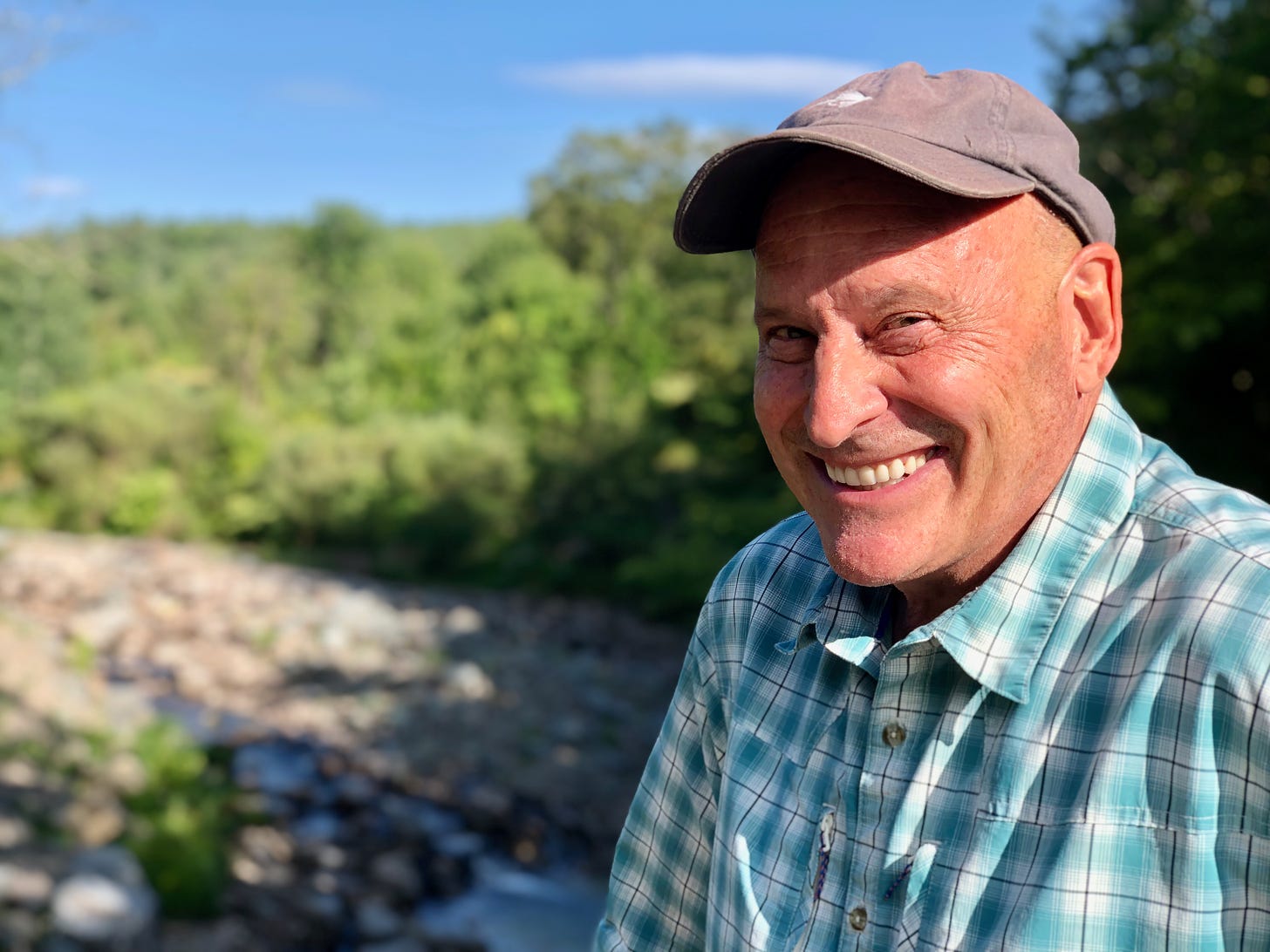
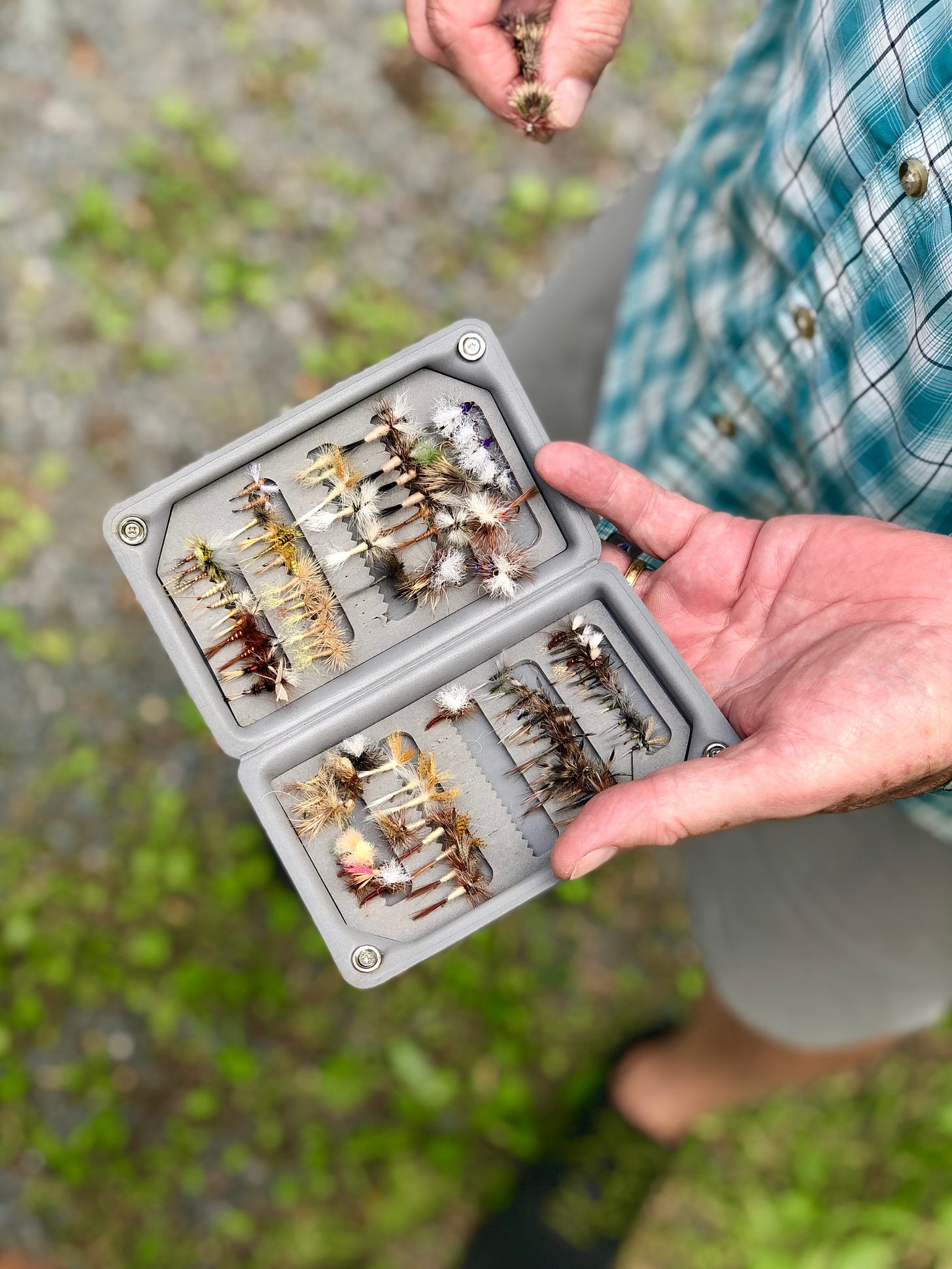
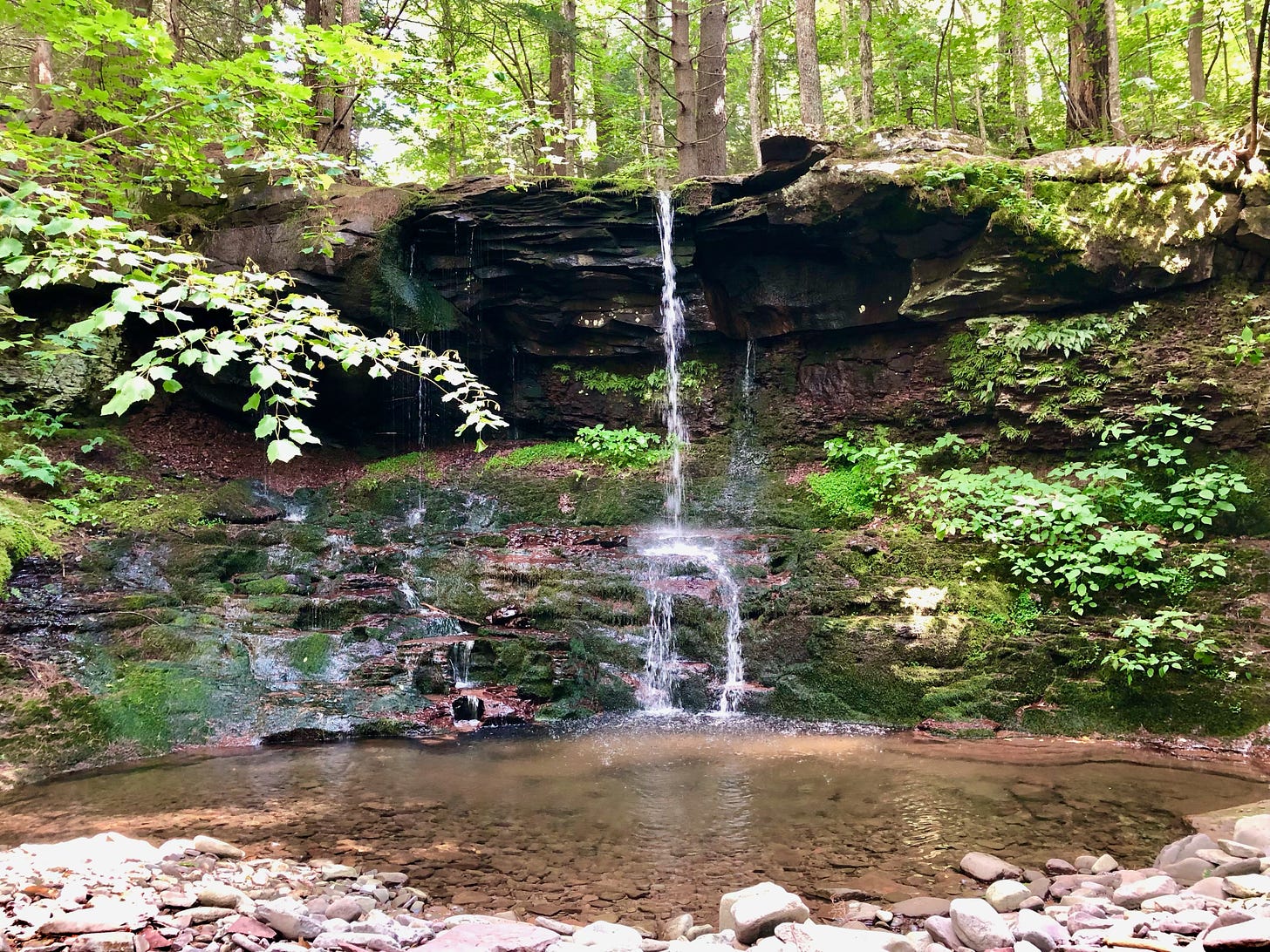
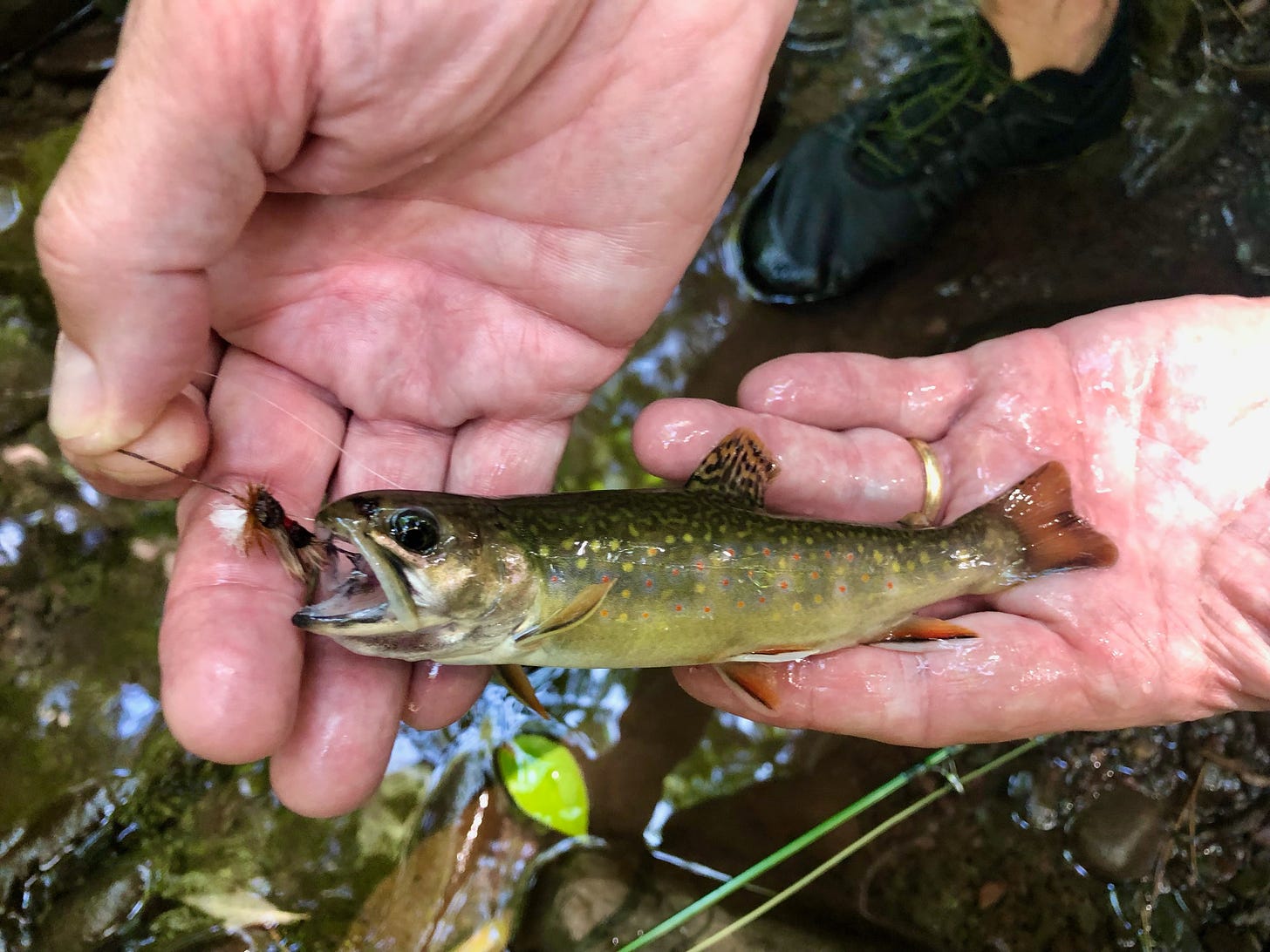

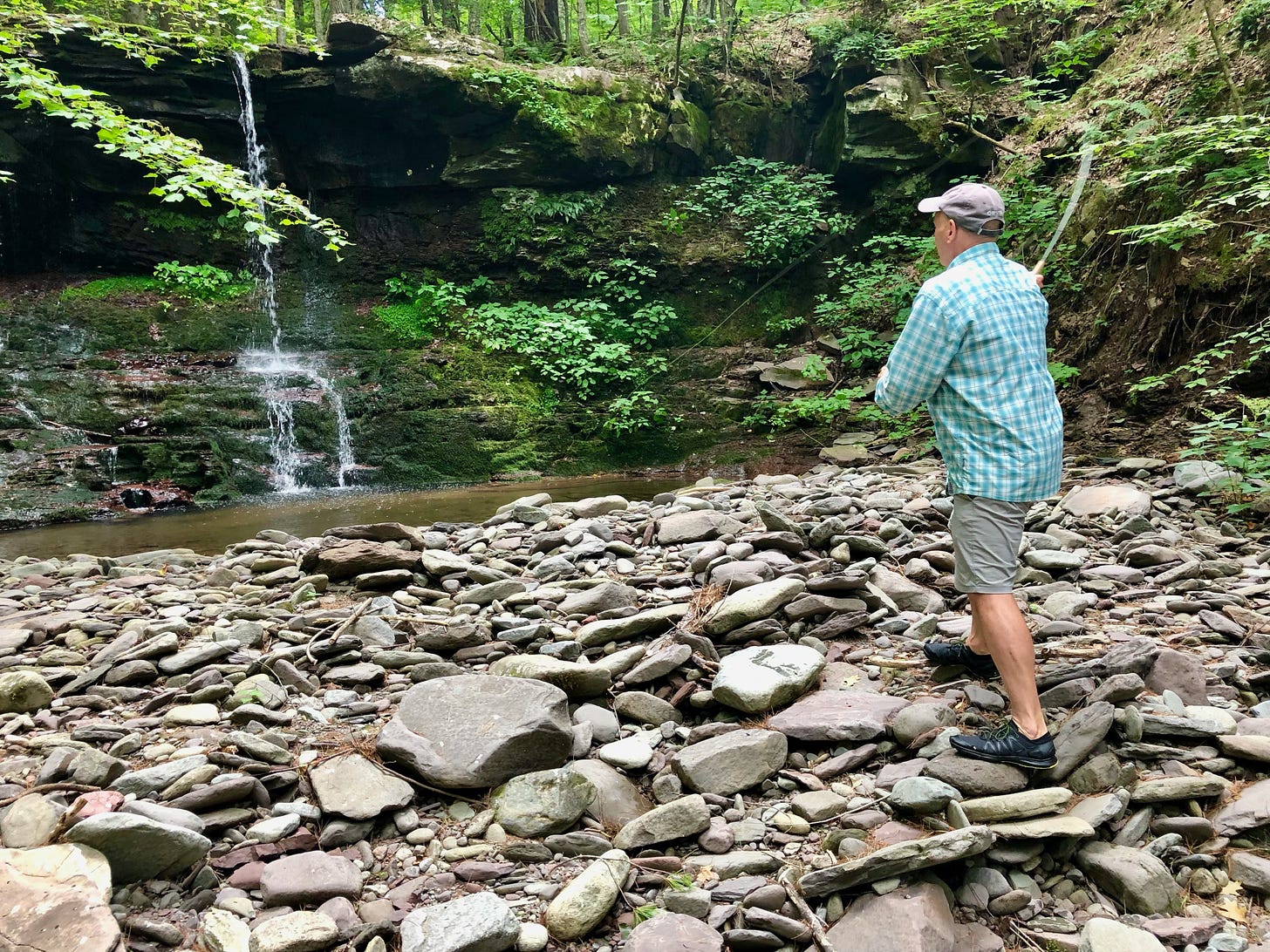
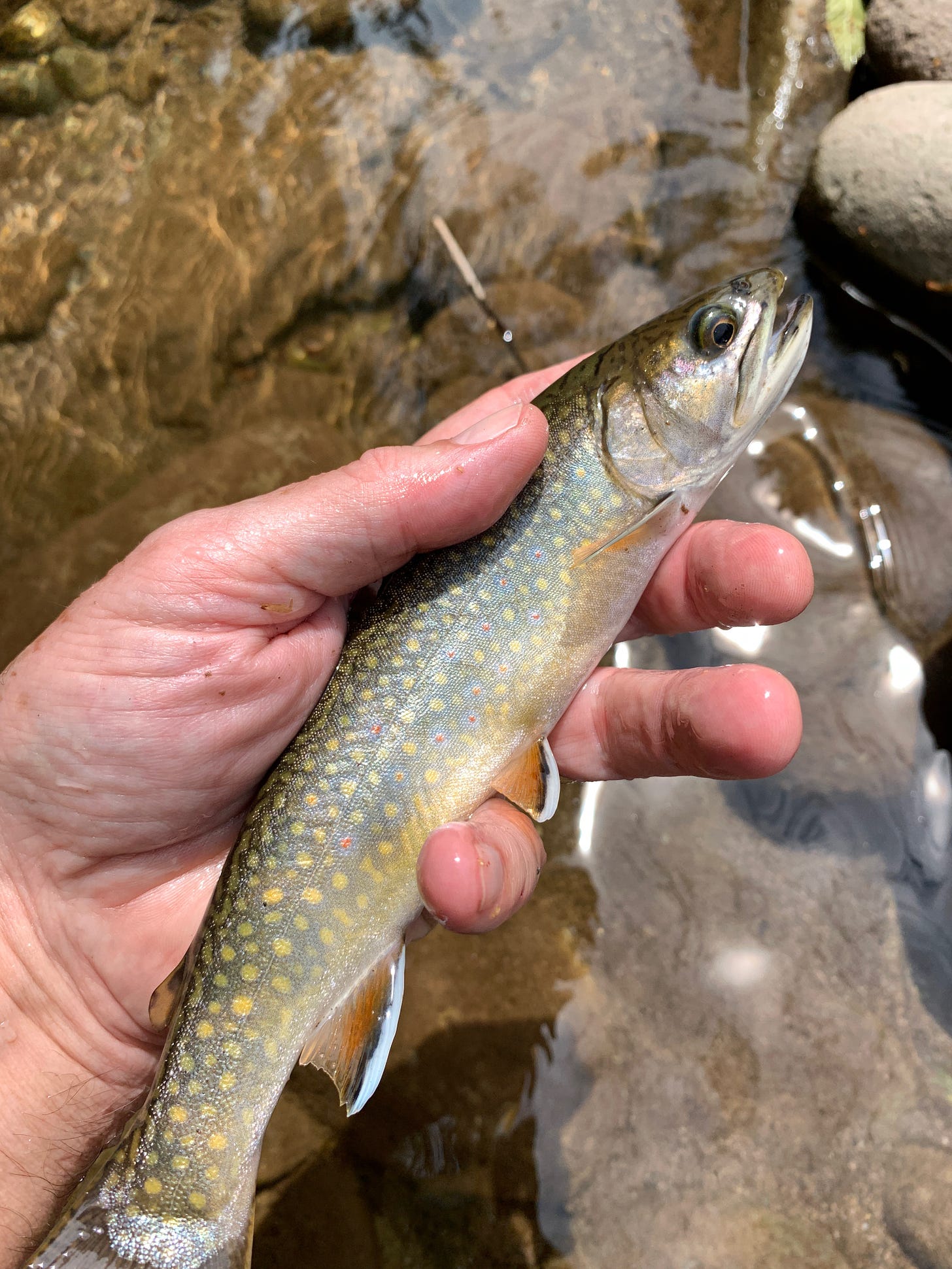
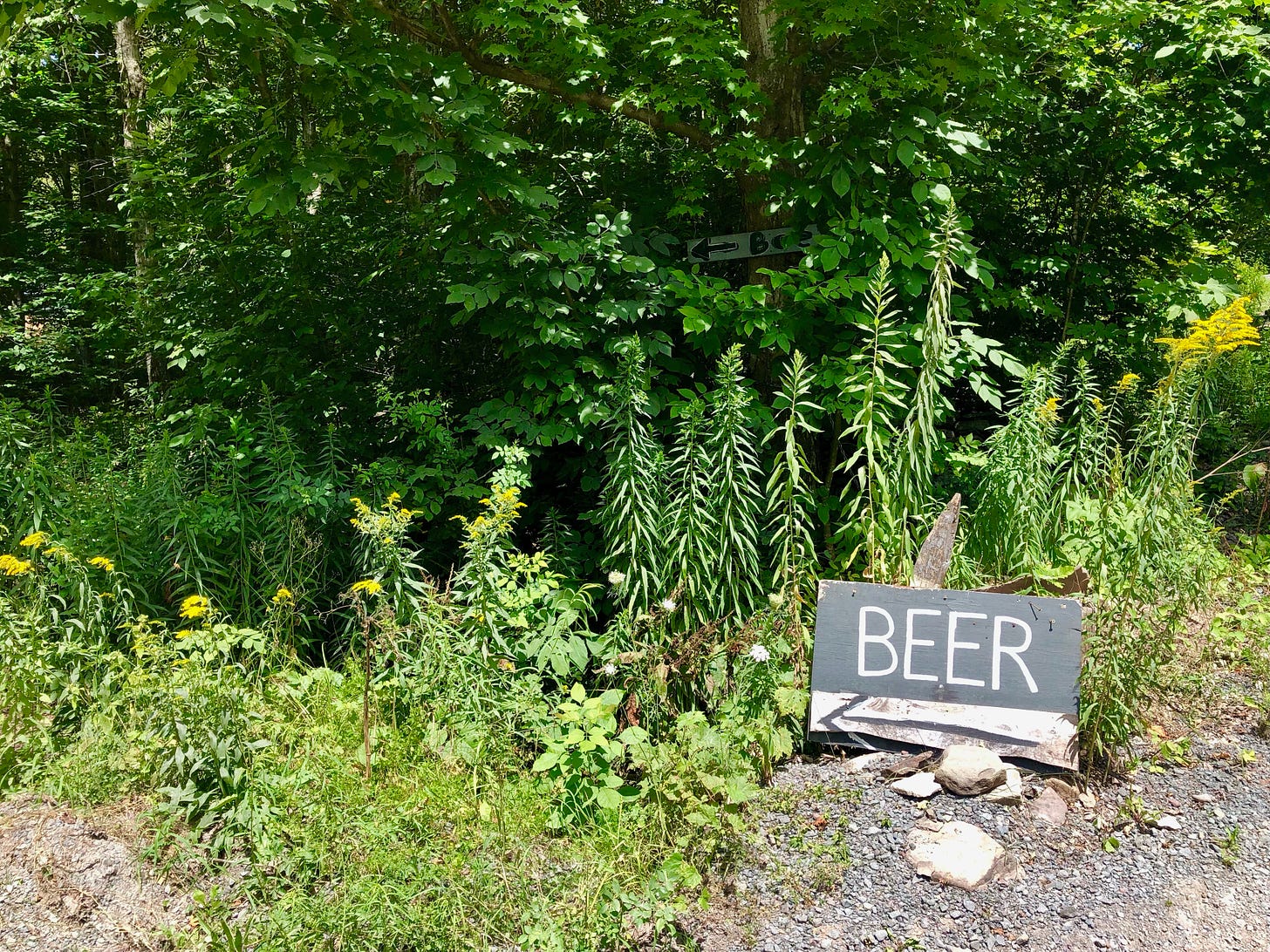
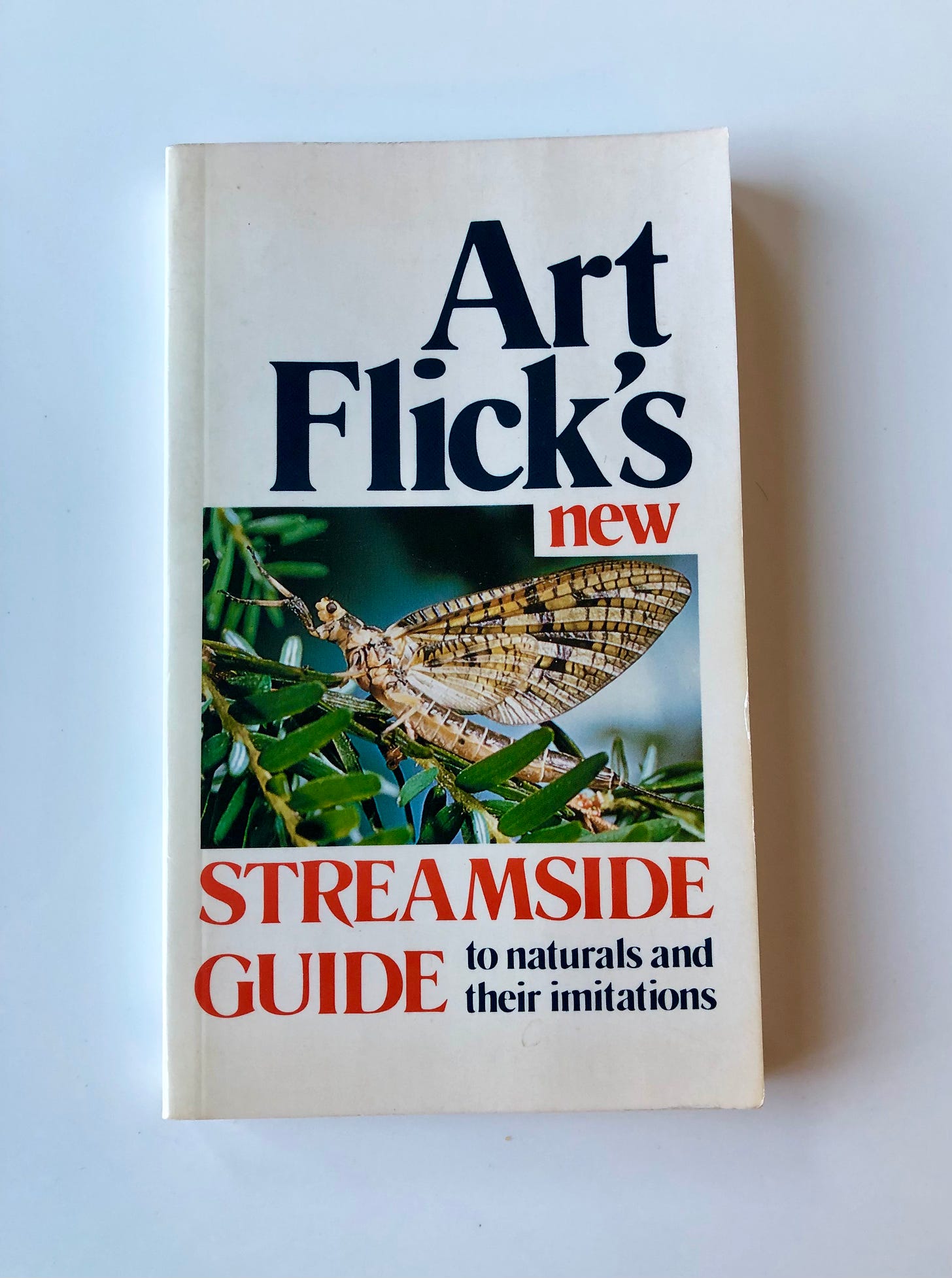
This is really beautiful, and I honestly teared up at the part of Jon wanting kids to misbehave over zoom and how they deserve, especially now a chance to just be kids
A real-life fish story! So many good things in it, not the least of which are your gorgeous photos. That’s a gorgeous part of NY state. Your summarizing paragraph towards the end is terrific.
The photo of the box of flies reminded me of sitting in my grandfather’s work room, tying flies. Mine didn’t look like real flies (his did), but it sure was fun.